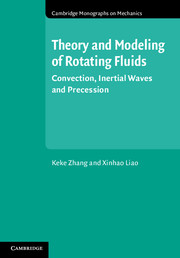Book contents
- Frontmatter
- Contents
- Preface
- Part 1 Fundamentals of Rotating Fluids
- 1 Basic Concepts and Equations for Rotating Fluids
- Part 2 Inertial Waves in Uniformly Rotating Systems
- Part 3 Precession and Libration in Non-uniformly Rotating Systems
- Part 4 Convection in Uniformly Rotating Systems
- Appendix A Vector Identities and Theorems
- Appendix B Vector Definitions
- References
- Index
1 - Basic Concepts and Equations for Rotating Fluids
from Part 1 - Fundamentals of Rotating Fluids
Published online by Cambridge University Press: 26 May 2017
- Frontmatter
- Contents
- Preface
- Part 1 Fundamentals of Rotating Fluids
- 1 Basic Concepts and Equations for Rotating Fluids
- Part 2 Inertial Waves in Uniformly Rotating Systems
- Part 3 Precession and Libration in Non-uniformly Rotating Systems
- Part 4 Convection in Uniformly Rotating Systems
- Appendix A Vector Identities and Theorems
- Appendix B Vector Definitions
- References
- Index
Summary
Introduction
The special fascination of the subject of rotating fluids stems from the fact that fluid motions strongly affected by rotation are fundamentally different from those in non rotating systems. With the motivation of explaining or predicting many atmospheric, oceanographic, planetary physical and astrophysical phenomena, the study of rotating fluids has increasingly occupied the attention of geophysicists, astrophysicists, and applied mathematicians. The subject of rotating fluids is also basic to many situations encountered by engineers and applied-fluid dynamicists in a number of important problems, ranging from centrifuges to the stability of rotating spacecraft carrying liquid payloads. Not surprisingly, a large number of theoretical, experimental, numerical, and observational studies have been made of rapidly rotating fluids over the past several decades.
Special characteristics of rotating flows lead to many inventive ideas that have been particularly and successfully applied to the theory of rotating fluids. There are primarily three special characteristics: (i) an overwhelming constraint on fluid motions imposed by controlling rotational forces, (ii) unique types of oscillatory motions, inertial oscillations and inertial waves, solely caused by the action of rotational forces, and (iii) a viscous boundary layer, produced by the effect of fast rotation, that differs markedly from that in non-rotating configurations.
These three fundamental characteristics underlie the foundation of the theory of rotating fluids, including inertial waves, rotating convection, and precessing/librating flows discussed in this monograph. Because a relatively simple mathematical solution describing inviscid wave motions can be readily obtained at leading-order proximation, theoretical progress on the corresponding viscous problems can usually be made via the elegant application of powerful asymptotic or perturbation methods.
The subject of rotating fluids contains two important but traditionally disjoint branches: inertial waves, and convective instabilities. Inertial waves describe the motion of an inviscid fluid occurring only in rotating systems, while convective motions, driven by thermal buoyancy, can take place in a viscous fluid in either rotating or non-rotating systems. Both problems, inertial waves and thermal convection, have been separately and extensively investigated. Inertial waves in rotating systems are governed by the Poincaré equation with the fluid viscosity being neglected, solutions to which in several systems have been discussed in Greenspan's monograph (Greenspan, 1968). For the problem of thermal convection, an additional equation governing the supply of buoyancy which drives convection is required.
Information
- Type
- Chapter
- Information
- Theory and Modeling of Rotating FluidsConvection, Inertial Waves and Precession, pp. 3 - 14Publisher: Cambridge University PressPrint publication year: 2017
